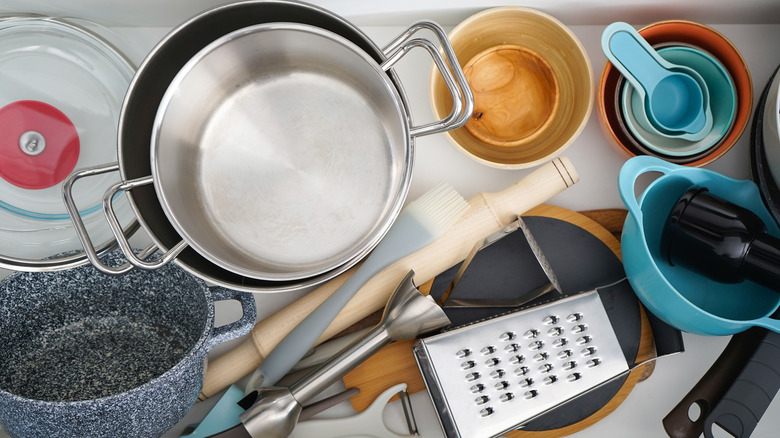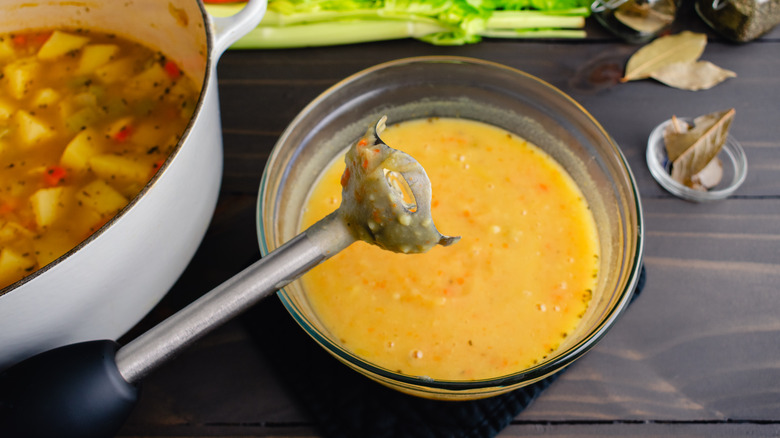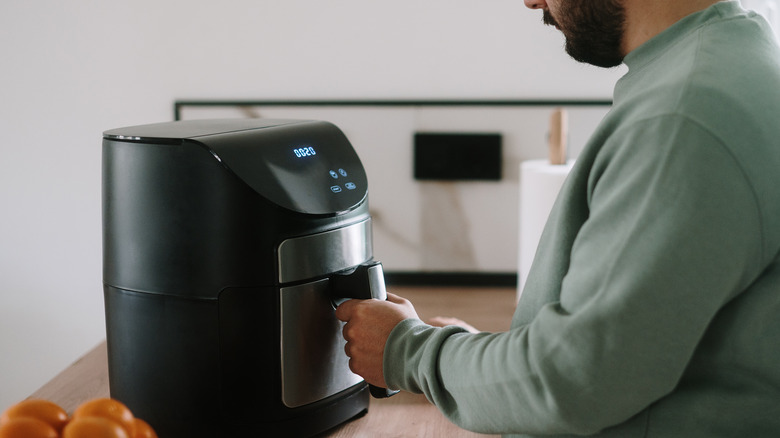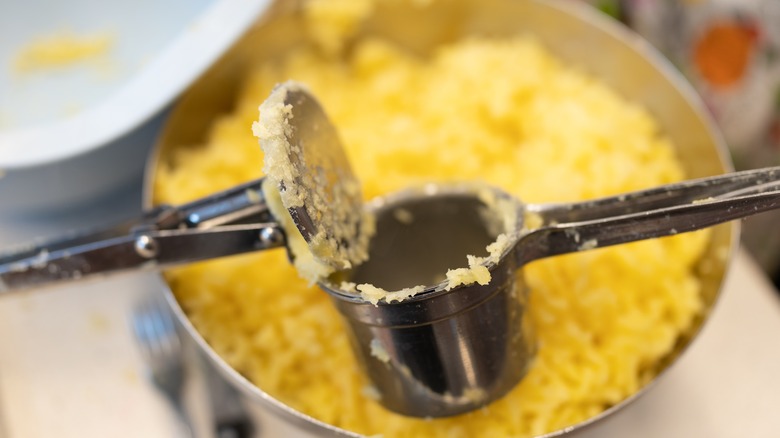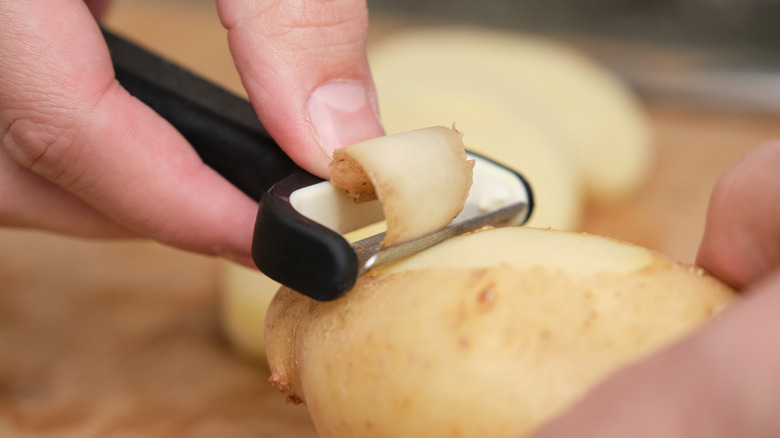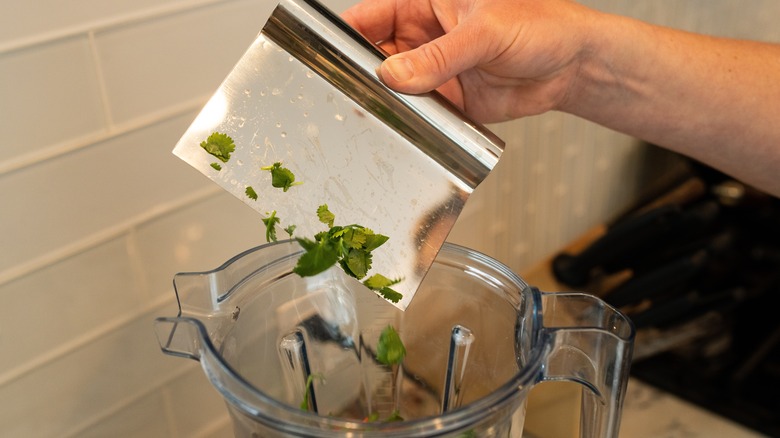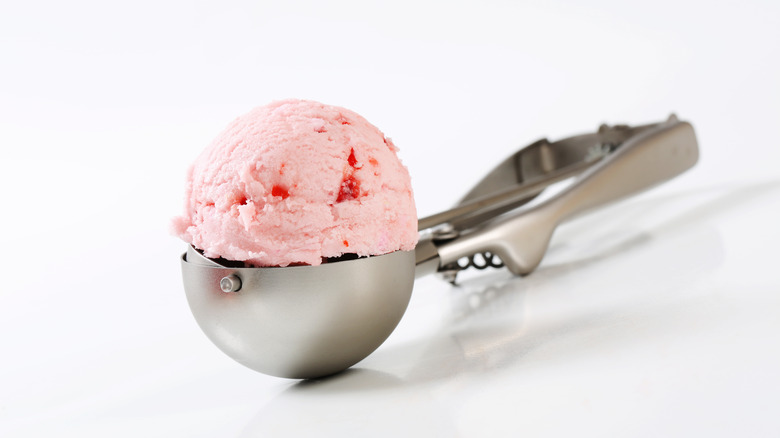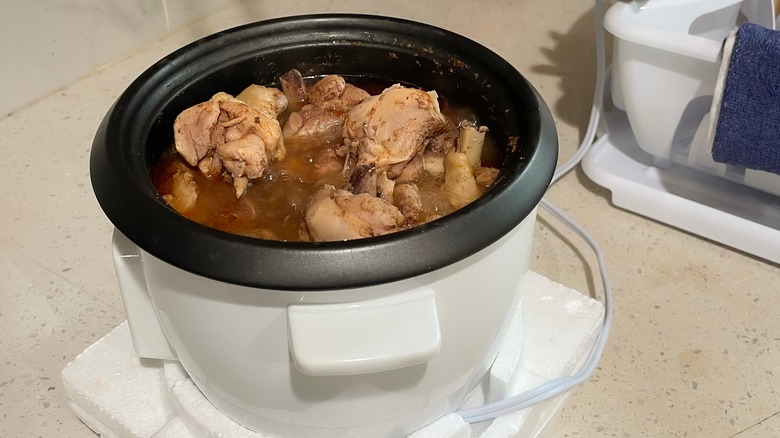9 Kitchen Tool Swaps That Make Cooking So Much Easier
There are times when working on your latest culinary masterpiece in a kitchen can be something of a chore. Sometimes, it's because things are a little cramped – kitchens are, after all, getting smaller. On other occasions, the tools you need – even the adorably tiny ones you impulse-purchased – are hard to find, out of reach, or just too much effort to set up. And then there are those moment where the right tool for the job just doesn't seem to cut it anymore.
It's times like this when the ability to swap a tool for something slightly more convenient would be a godsend. Where a tool you use for one task is more than capable of performing another. After all, there is a definite agency to be found within the realm of decluttering even when space isn't at a premium.
Here, then, are some surprising ways to swap out kitchen tools in such a way that you can cut down on the frustration of too many gadgets. A way to maximize productivity and save space at the same time.
1. Milk frothers for dressings
Dressing are the life of any salad, and in an increasingly health-conscious world, the secret of how to make a great one has become a bucket-list-level aspiration. The traditional way involves one of two methods. First, you can combine the ingredients using a whisk. Second, you can get a food mixer to do the work for you.
Regardless, the goal is the same: All dressings are mixtures of acids and fats. The whisking is necessary to create an emulsion – a mixture of two liquids that would not combine of their own accord. It can take quite a bit of work to get some of the more flavorful dressings to combine, and getting out the stand mixer sometimes feels a little bit like overkill. Which is where the milk frother comes in.
Milk frothers are small battery-powered whisks designed to aerate milk. However, their high rotational speed also makes them perfect for the creation of a silky-smooth salad dressing.
Simply place the ingredients in a cup or beaker and lower the milk frother into the mixture, taking care not to switch it on until the business end is fully submerged. Blitz for around thirty or forty seconds or until the dressing develops a uniform texture and appearance. It works less well for more viscous dressings such as ranch, but for anything less liquid — even prepping eggs for scrambling — it's something of a game changer.
2. Stick blenders for sauces
The art of sauce making dates to Roman times, if not earlier. In traditional French cuisine, a specialist saucier is an essential part of the brigade de cuisine system. The dedicated home cook, meanwhile, is a brigade of one; knowing how to create a simple sauce is just one of many hurdles.
Of course, not all sauces are equally complex. A simple béchamel consists of milk, flour, butter and a little elbow grease. Combining these ingredients with a whisk or a spatula is not entirely without risk – lumps do happen – but fixes are available.
Meanwhile, the jeopardy involved in creating something more elegant – such as a hollandaise sauce – is more visceral. As with dressings, the goal is to create a smooth emulsion, in this case from egg yolk, lemon juice, and melted butter. The traditional method involves whisking the eggs and lemon together over a bain-marie and then gradually adding melted butter. Needless to say, the risk of separation is very real.
Which is where the stick blender comes in. Simply place your yolk and lemon mixture in a tall cup wide enough to accommodate the blender, pour in the melted butter, and blitz. The high rotational speed of the blades creates a perfect emulsion in seconds. This method is useful elsewhere; you can make a custard, remove unwanted lumps from sauces, create smoothies, whip cream, and even make a flawless fresh mayonnaise.
3. Coffee grinder for spice mixes
Coffee tastes have changed over the years, and the simple cup of joe of old bears little resemblance to the myriad of flavors, varieties, and options available today. Indeed, in recent years the popularity of preparing freshly roasted beans at home via a blade or burr grinder has blossomed as freshly ground coffee at home has become more possible
Still, while both types of grinders are built with a specific task in mind, that doesn't mean that they can't be repurposed. One of the reasons it is difficult to recreate the spice profiles typically found in a multitude of world cuisines has to do with the spices we use. Shop-bought spices simply cannot compete with freshly ground, recently toasted spices made at home. While dedicated spice grinders are available, those who already have a coffee grinder — particularly of the bladed variety — can easily repurpose them.
Of course, care must be taken to clean the blades before and after use so as to prevent unwanted flavor contamination, but the good news is that bespoke uses for the coffee grinder do not end there. They can also be used to make popcorn salt, breadcrumbs, gluten-free flour, powdered sugar, and so much more.
4. Air fryer for French toast
The days of the air fryer existing as a niche product used only be the chosen few are long gone – the product is currently sitting at over 75 million units sold. In its modern form, it was first introduced by Dutch electronics giant Philips back in 2010, and after an initial, muted response, it hit zeitgeist levels of hype just a few years later.
Its central conceit – the ability to brown food without having to immerse it in oil – was an obvious selling point to some, and the internet was soon awash with tips, tricks, and air fryer hacks designed to help people get the most out of their product. Still, the focus on its benefits to health distracted from its inherent versatility. The air fryer is capable of much more.
Take French toast, for example. It's one of those items crying out for the air fryer treatment. The usual steps apply: make your egg mixture and dip your sliced bread into it. Instead of reaching for a skillet, however, simply place your toast in a parchment-lined air fryer, set to 350 degrees, and cook for around four minutes before flipping it over and giving it another couple of minutes.
Nor is French toast the only thing that the air fryer can accomplish without all the fuss and mess that goes along with more conventional ways of cooking. It's great for toasting nuts, delivering perfectly hard-boiled eggs, roasting garlic, toasting spices, and melting cheese.
5. Potato ricer for hummus
We live in a world where analog gadgets are sometimes viewed with abject suspicion. Everything needs to be powered, digital, labor-saving and, if, possible, smart. The food processor excels at overloading potential owners with adjective after adjective: slice, dice, chop, shred. All useful tasks but still, can it rice?
Or more specifically, can it make mash? Well, yes, it probably can, but it would be of an inferior quality. That's because one of the secrets to making perfect mash is to do it by hand; the blades of a food processor are too aggressive, and if you overmix the mash, it becomes a gluey mess. If you like your mash extra fluffy, you need to go the extra mile. You need a potato ricer.
The singular function of a potato ricer speaks to its efficacy; it's designed to make mash. And yet, there are hidden uses that go well beyond that remit. The ricer itself acts as a strainer of sorts, so it is possible to dump in a tin of chickpeas — keeping some of the aquafaba for later use — add some tahini, minced garlic, and seasoning and create a very respectable hummus. You might have to pass it through the strainer a few times and mix in some lemon juice and aquafaba if the mixture is too thick; a drizzle of olive oil never goes amiss, either.
6. Swiss peelers for grating cheese
It sometimes feels like there's a kitchen tool for every job, a never-ending litany of bespoke mono-use designs destined to lie in forgotten drawers until the heat death of the universe takes us all.
Take the Swiss peeler, for example: an inexpensive, essential item that always seems to find its way onto best potato peeler lists with seemingly little effort or marketing. And yet, it can do so much more than peel the odd root vegetable or two.
Known in Europe as the Rex, the Swiss Peeler has been around since its invention in 1947 by Swiss engineer Alfred Neweczerzal. The time he spent in the army peeling endless mountains of potatoes convinced him that there had to be a better way. Some fifty million sales later, he more or less proved his point.
But the Swiss peeler can handle a lot more than that. It can zest lemons, slice curls of butter, shred lettuce, and even work as a mandoline when you need to slice something ultra-thin, such as a clove of garlic for a traditional aglio e olio or meat for a charcuterie platter.
Still, the peeler really comes into its own when you need some grated cheese in a hurry. Drawing the blade over a block of cheese produces some wafer-thin slices ready to be chopped into neat little strips in short order. This method works well with low-moisture mozzarella, or cheddar, and is not averse to shredding melting cheeses.
7. Bench scraper for mincing garlic
Things often move in cycles. There was a time when villagers took their milled flour to a baker. Later, people began baking at home before deciding it was too much effort and returning to industrial-scale outsourcing. Then 2020 hit, and all of a sudden, the whole do-it-yourself thing was very much back in fashion, with people obsessing over the best way to make quick breads, pastries, and sourdough masterpieces.
Those new to the skill set had to tool up. There were tins to buy, proofing baskets to obsess over, starter cultures to share, and, of course, bench scrapers to admire. They are, after all, one of the most useful kitchen aids out there. Utilized as a rudimentary knife to cut or portion dough as it moves around the work surface, the bench scraper is also really useful when it comes to cleaning up; it can gather up crumbs, finely chop herbs, and even scrape dough off other utensils.
It comes into its own, though, when working with garlic. Mincing garlic is one of those culinary skills that is difficult to master. Garlic cloves are fiddly things at the best of times and trying to hold one still as you chop can be challenging. Fortunately, the long flat blade of the dough scraper is perfectly suited to sheer off vertical slices of garlic that — when laid flat — allow you to mince to the desired consistency quickly and efficiently.
8. Ice cream scoops for meatballs
Ice cream — even the kind you make at home without a machine — is one of those foods that cries out for portion control. Moreish and calorific, it's one of the few food items that people eat while it's still frozen; little wonder, then, that we developed a tool for getting it out of the tub and into our bellies.
The traditional ice scream scoop has two basic functions. First, its robust design allows it to cut through any resistance the frozen dessert presents. Second, upon release, it produces a pleasingly spherical scoop of frosty goodness. Alas, the scoop doesn't always get quite as much use as it deserves. Fortunately, there are ways to press it into other gainful employ.
An ice cream scoop is perfect for portioning out cookie dough, which, as any baker will tell you, begins life as little round balls resting atop a baking tray. It does the same trick with melons, squash, or other soft vegetables, but has one more trick up its sleeve for something people eat on a more regular basis.
It turns out that an ice cream scoop makes perfectly portioned meatballs. The process is close to being self-explanatory; scoop out a ball of your prepared meatball mix, and you're good to go. Just remember that raw meat and dairy do not mix, so clean the utensil thoroughly after use.
9. Rice cookers for soup
Rice is one of those kitchen staples that some people simply cannot seem to get right. Enter the rice cooker. It's a simple enough tool. The typical rice cooker consists of a bowl, heating plate, thermostat, and digital display with programable functions. They are fully automated and very much designed as a walk-away solution; switch them on and get perfect rice every time. Which is fantastic if that's what you're in the mood for but less so if you're hankering after something else. Which is why it's great to know that rice cookers can do so much more – like cooking soup. Cook your broth and aromatics, employing the rice cooker like a slow cooker, then add in rice or pasta near the end of your cooking time.
Cakes, beans, polenta, deep-dish pizza? You name it, a rice cooker can handle it. The trick lies in the cooker's basic design: bowl, heating plate, and thermostat, the same features you would find in your typical Crock-Pot.
The downside is that the rice cooker's design brief means that programmable functions are of less use here. You can still control certain elements such as heat and time, but the rice cooker still thinks it's cooking rice, so you need to keep an eye on things while they bubble away. Still, in the case of soups, this isn't much of a problem; just remember to give it a stir every 15 minutes or so.
